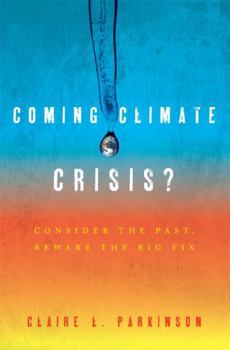Coming Climate Crisis?: Consider the Past, Beware the Big Fix
Select Format
Select Condition 
Book Overview
Decisively cutting through the hyperbole on both sides of the debate, distinguished NASA climatologist Claire L. Parkinson brings much-needed balance and perspective to the highly contentious issue of climate change. Offering a deeply knowledgeable overview of global conditions past and present, the author lays out a compelling argument that our understandings and models are inadequate for confident predictions of the intended and unintended consequences...
Format:Paperback
Language:English
ISBN:1442213264
ISBN13:9781442213265
Release Date:March 2012
Publisher:Rowman & Littlefield Publishers
Length:432 Pages
Weight:1.20 lbs.
Dimensions:1.0" x 5.6" x 8.7"
Customer Reviews
2 ratings
Good advice on the "Climate Crisis".
Published by Thriftbooks.com User , 13 years ago
I have just finished reading Claire Parkinson's book "Coming Climate Crisis?" and I am very impressed with it. Her grasp of the principles of scientific investigation and the uses of scientific and "scientific?" information is both broad and deep. She has done a great job of outlining the background of climate science and climate change, what people can do right and do wrong, and the perils of jumping to conclusions and basing actions on inadequate data, imprecise and incomplete analyses, and media hype that takes the place of reasoning. Her conclusions on the dangers of geoengineering are cautious and sound and I hope that she will be listened to, both by the climate community and, the public and the press. Unfortunately, because she are both right and quiet, she may well become a Cassandra in the climate community. She states (p. 338) "I have no confidence that objectivity and levelheadedness will prevail." Exaggeration, the desire for fame, and the need to do something "now" will always overwhelm clear thinking, the need to wait for the right answer instead of the quick one, and the desire to make a quick buck from a supposed crisis. I am not an expert in the climate field but I am a scientist with a lot of experience. She is correct in doubting the integrity of some scientists who are quick to jump on a bandwagon and even quicker to jump off it when the tide of informed opinion turns. Her chapter on "Compounding Social Pressures" is about the best that I have read on the relationship between science and society and it should be required reading for university science students. And her "Closing Plea" should also be read and heeded by any and all of those who raise their voice in the climate debate, whether scientists, laymen, or politicians. Charles J. Robinove (USGS, retired)
Informative and Credible -
Published by Thriftbooks.com User , 13 years ago
NASA climatologist Parkinson contends that our understandings and computer models are inadequate for confident predictions of the consequences of various projects being considered to modify our future climate. Parkinson also provides readers with a summary of 4.68 billion years of earth's climate change history and confirms that global warming is real. Earth has already undergone massive natural large-scale climate change in response to changes in the sun, the amount of volcanic dust in the atmosphere, El Nino, and sea ice. Human factors include greenhouse gas emissions and land use changes. We should avoid paralysis from uncertainty; the best solutions will be win-win - eg. adding alternative energy sources. The earth's major greenhouse gas is water vapor, then CO2, methane, nitrous-oxide. Without any greenhouse gas, however, the average Earth's surface temperature would be 0 instead of the 60 degrees now. The ocean conveyor flow can take 1,000 years to return to the northern North Atlantic once leaving there. Our potential future global warming of 5 degrees C. is equal to the change from the height of ice-age conditions to today. About half the CO2 emitted by humans in the past few decades has stayed in the atmosphere, 30% has gone into the oceans, and 20% into the land biosphere. The average rate of CO2 increase from 2000-08 was 2.1 PPM, 4X the rate of the prior 200 years. Our CO2 was 280 PPM at the start of the Industrial Revolution, and hit 386 in 2008. Methane is the #2 human-induced greenhouse effect. Natural sources account for about one-third (anaerobic decomposition in wetlands), and two-thirds is man-made (rice fields, coal mining, landfills, livestock. The amount has gone from 730 PPB in 1750 to 1,800 in 2006. Partially decomposed organic matter has resided for thousands of years in permafrost that covers 25% of the Earth's land area; it is ready to release CO2 and methane. Sulfur emissions can act as cloud condensation nuclei and increase cloud reflectivity; they also create acid rain. Atmospheric levels have stabilized and somewhat declined since 1989 because of international efforts and regulation. Thus, clean air efforts have increased global warming. Parkinson says the best estimates are that net ground use changes are thought to have also contributed to cooling. Earth's ten warmest years (measured overall) in the years 1880-2006 are all within the last 12 years. Adding CO2 to the oceans increases their acidity, which impedes calcification (coral reef and shell formation) and is a contributor to species extinction. Warmer water compounds the problem - about 30% of our warm-water coral has disappeared since 1980. Ocean surface pH has fallen from 8.18 to 8.07 over the last 200 years. Mainstream expectations are that in this century sea level will rise 0.18 - 0.59 meters; others project an increase of 0.8 - 2.0 meters. A one meter rise would wipe out 21% of Bangladesh's land area, now holding 15 million. A total melting of land-





